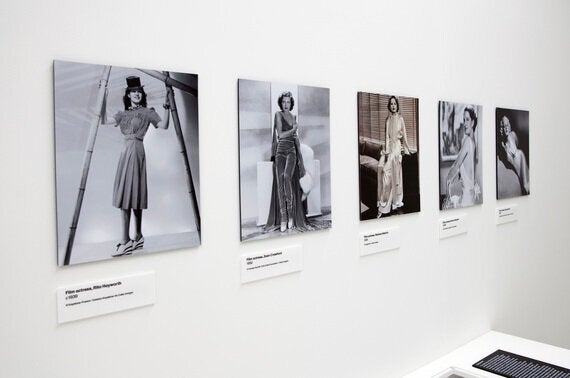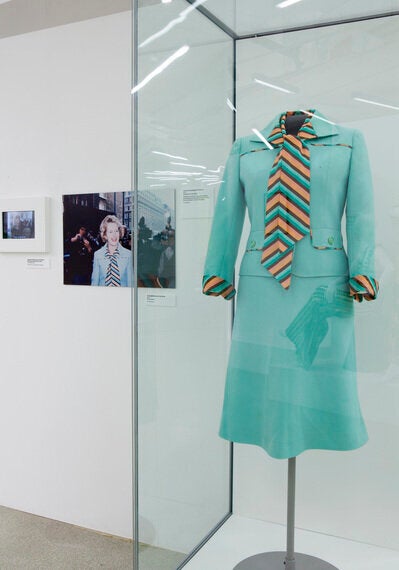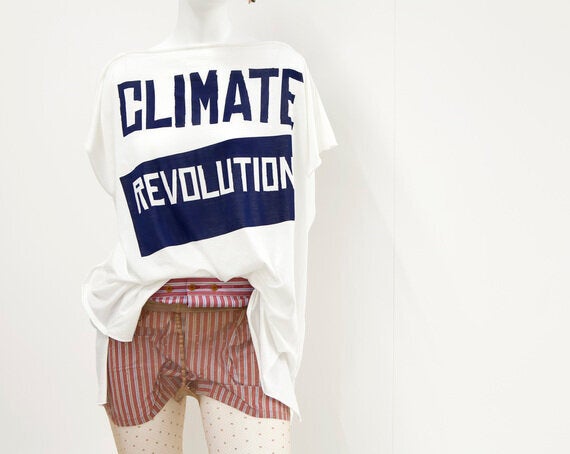
The Design Museum's new exhibition Women Fashion Power examines how female fashion has changed in line with emancipation and showcases examples of how powerful women have used fashion to define and enhance their position in the world. But by including the word 'power' in their exhibition title, I can't help but feel the Museum has set itself up for a fall.
The last 150 years of women's fashion is analysed through an immersive visual timeline that explores how female fashion has transformed from the restrictive boned corsets of the nineteenth century to the statement Louboutin heels of today (though given the restricted movement in Louboutin's fetishist high heels, it's questionable how much progress has been made since the corsets! ).
Nevertheless the approach is a great success as the visitor weaves their way through the displays that include items from Vivienne Westwood's glorious back catalogue, a beautiful lace shirt belonging to a WSPU suffragette with the WSPU colours woven into the sleeves, protest t-shirts from Katherine Hamnett and a Coco Chanel designed suit from 1955.

And these are accompanied by a wonderful collection of photos, magazines, sketches and many other objects to show the development of female fashion, and the drivers for these changes.
I liked how the exhibition does acknowledge that there are challenges for women and the forensic analysis on what they wear. When looking at powerful women in the public eye, a picture of Hilary Clinton is accompanied with commentary on scrunchie-gate and there's much observation on Angela Merkel's preference for very plain trouser suits.
There's a lovely glamorous section about the rise of the strong woman archetype in Hollywood in the 1930s, with Greta Garbo, Marlene Dietrich, Jean Harlow and Joan Crawford amongst others. These women were hugely influential, as were their images, but I liked how the curators of the exhibition say how ironic this is given these women were made by the male-dominated Hollywood studio system that also exploited and profited from them. Style over substance indeed.

And even today, as the exhibition explores the link between empowerment and expression of female sexuality (with the obligatory picture of Madonna in Gaultier), this is interestingly juxtaposed with a copy of the famous "Hello Boys" Eva Herzigova advert for Wonderbra - the challenges for female expression evident in a world that wants to commoditise female sexuality for profit.
All good but sometimes the exhibition does itself get a bit confused with this tricky conundrum, inadvertently undermining women with their focus on fashion.
One of Margaret Thatcher's suits is on show and this is accompanied with a film clip of Maggie discussing which dress in her wardrobe she wore to an event at the UN at the time of the Falklands War. There was something deeply unsettling about watching the most powerful woman of her time reduced to talking about her reliable go-to navy silk dress. I wasn't impressed or interested in her rationale on why this dress, I just thought the whole thing was so patronising and insulting. No-one ever gave Reagan this line of questioning.

The curators also obtained donated outfits from high-profile women as examples of which items in their wardrobe make them feel powerful. Now, setting aside the very uncomfortable suggestion that power comes from what you're wearing, there is also the bizarre inclusion of items from HSH Princess Charlene of Monaco.
Now, I mean, where to begin? Not only is figurehead royalty not the same as actual power but she is the wife of the heir to the throne, not the actual heir. And let's be frank, with the rumours surrounding that marriage I felt this was an example of how much female power is tokenistic in today's society - attention to the pretty consorts imprisoned in their gilded cages and not enough actual power players. Couldn't they have approached Oprah instead?
As a display that examined the parallel and deeply intertwined developments between female emancipation and fashion, this exhibition is interesting. But the use of the word 'power' made me feel really uncomfortable.

Female power, like male power, should not have any link whatsoever to clothes. The constant attention and running commentary on what women in the public eye are wearing shows how far we are from equality.
However a quote from Shami Chakrabarti at the close of the exhibition was interesting. "What we wear does matter" she says. And she focuses on those with freedom to wear what they want compared with a "uniform imposed on so many people, against their will."
This is an interesting point but we shouldn't be comparing ourselves with those at the bottom of the rung, but with those at the top. So interesting as this exhibition is, I came away from the Design Museum more convinced than ever that women won't have true power until what we wear becomes completely irrelevant.
Design Museum, London to April 26, 2015
Admission: £12.40 (concessions available)
Installation images by Mirren Rosie.